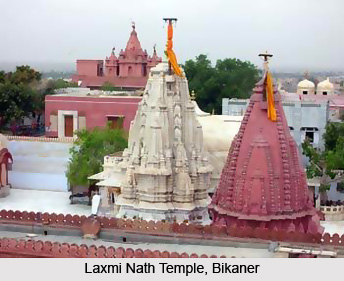 Laxmi Nath Temple is the most ancient temple of Bikaner city, Rajasthan and it was erected during 1488 by Rao Bikaji during the regime of king Rao Lunkaran. The construction of this Indian temple was accomplished in 22 years and further modifications to the temple were performed under the royal orders of the Maharaja Ganga Singh. The historical Laxmi Nath Temple boasts of superb architectural characteristics and idols of religious deities like Lord Vishnu and Goddess Lakshmi. The king of Bikaner revered `Laxminath` as the Lord of Bikaner and treated themselves as the ministers or `Deewans` of Lord Laxminath Ji and reigned over the States as royal regents of this Hindu deity. Laxmi Nath Temple has been constructed from red stone and marble and it is believed that the red stone of this temple had been imported from Jaisalmer. The temple is a significant Vaishnava shrine.
Laxmi Nath Temple is the most ancient temple of Bikaner city, Rajasthan and it was erected during 1488 by Rao Bikaji during the regime of king Rao Lunkaran. The construction of this Indian temple was accomplished in 22 years and further modifications to the temple were performed under the royal orders of the Maharaja Ganga Singh. The historical Laxmi Nath Temple boasts of superb architectural characteristics and idols of religious deities like Lord Vishnu and Goddess Lakshmi. The king of Bikaner revered `Laxminath` as the Lord of Bikaner and treated themselves as the ministers or `Deewans` of Lord Laxminath Ji and reigned over the States as royal regents of this Hindu deity. Laxmi Nath Temple has been constructed from red stone and marble and it is believed that the red stone of this temple had been imported from Jaisalmer. The temple is a significant Vaishnava shrine.
Architecture of Laxmi Nath Temple
Laxmi Nath temple is a principle temple belonging to the Vaishnava sects and currently the temple is associated with `Devasthan Vibhag`, though today it is an independent organisation. Sophisticated forms of sculptural art, beautiful images and creative form of architecture is present inside the temple premises. The throne of Lord Laxminath is situated in the temple which also possesses an idol of Goddess Lakshmi and Lord Vishnu in a State of Embrace. This particular idol measures about one and a half feet in height and is based on a square-shaped stone platform. The signs of Shri Suryanarayanji, Shri Neelkanth Mahadev, Shri Roopchaturbujji, Shri Badrinarayanji, Shri Magavidyaji, etc. are also existent in the temple grounds.
The religious rituals observed in the Laxmi Nath Temple follow Vaishnava traditions and the `aarti` is performed four times during the day. Sacred food or `prasad` is offered to the deity of the temple and a special `bhajan` dedicated to the legendary saint Meera Bai is also sung regularly, as a form of worship. One will notice that the statue of Goddess Lakshmi is beautifully garlanded which provides a mesmerizing view of the deity. Silver framework has been employed along the temple doorway which imparts an aesthetic appearance to the temple.
Fairs of Laxmi Nath Temple
Fairs like `Gita Jayanti`, `Nirjala Ekadashi`, `Janmashtami`, `Kartik Ekadashi` and `Ramnavami` are held within the premises of the Laxmi Nath Temple.





















